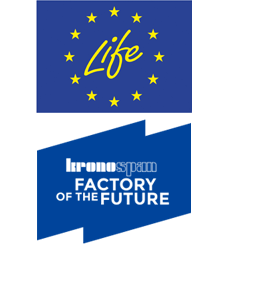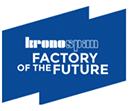This first action, a central pillar of the project, was used to assess the technical and economic feasibility of the Factory of the Future project. It was during this phase that the Kronospan factory performance was assessed in order to determine the potential for improvement of the current equipment and processes and to define the characteristics of the new equipment and processes. Following this action, a pre-study report was published (Report on pre-study: specification of improvement), containing a summary of the proposed solutions and evaluations.

Energy consumption study
Two options were proposed in order to achieve the energy targets set by the project: a reduction in natural gas consumption to 10% compared with 2010 and a reduction in CO2 equivalent emissions to 20% compared with the same year.
Option 1: Co-generation unit
This first option involves the installation of a co-generation/Combined Heat and Power (CHP) unit using wood by-products from internal and external sources.
Option 2: Wood Dust Generator
The second option involves the installation of a Wood Dust Generator which transforms a large part of the wood residues into fuel usable in the existing wood dust burners. This option, backed by the burn capacity of the biomass grate firing unit, allows that most of wood residues on the factory site to be reused even before the installation of a co-generation unit.
The study estimates that theoretically Option 2 could achieve the stated objectives in terms of energy (with the exception of green electricity production) without recourse to the installation of a co-generation unit and with virtually no dependence on external wood fuel.
The conclusions of the pre-study were that, whichever option is selected; Kronospan would achieve its goal of 90% use of bio-fuel. Specific improvements would nevertheless be necessary to achieve the targets set by the project. Special attention would need to be paid to the importation of wood as an energy source, mainly because of the trend in supply and prices in the Greater Region.
Water consumption study
The aim of the water consumption study was to evaluate the collection process for rainwater and condensates in terms of both quantity and quality. The use of these two alternative water sources should be maximised in order to reduce day-to-day tap water consumption by 70% compared with 2010.
The study showed that not all surfaces necessarily lend themselves to rainwater collection. In addition, certain equipment requiring a particularly high quality standard cannot operate with these alternative sources because of the variable quality of the water collected.
As a result, an additional optimisation effort would be required in order to compensate for the consumption of the equipment that cannot tolerate any significant variation in water quality.

